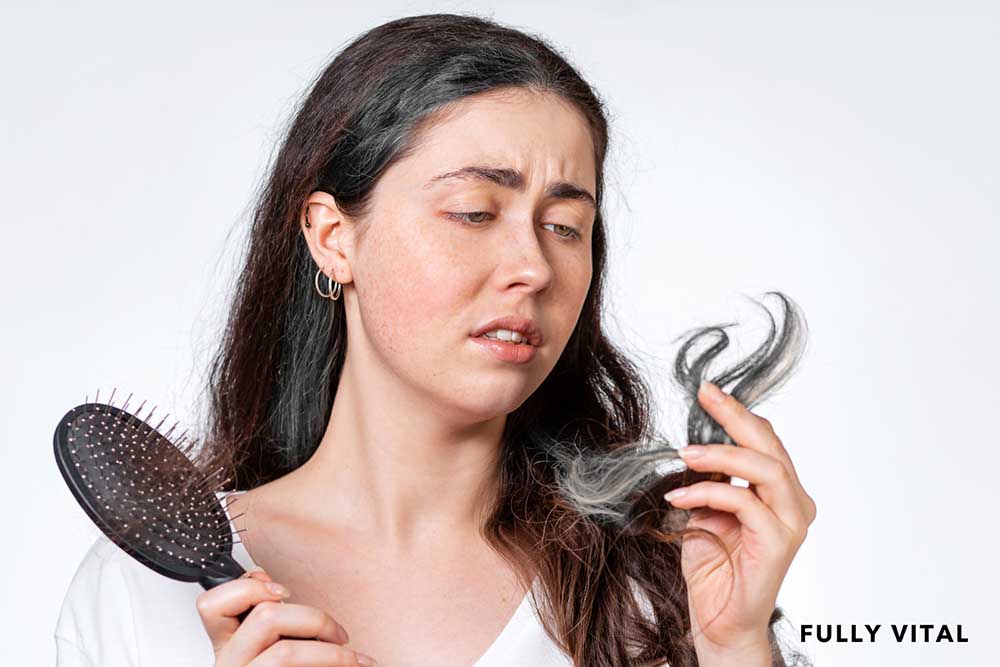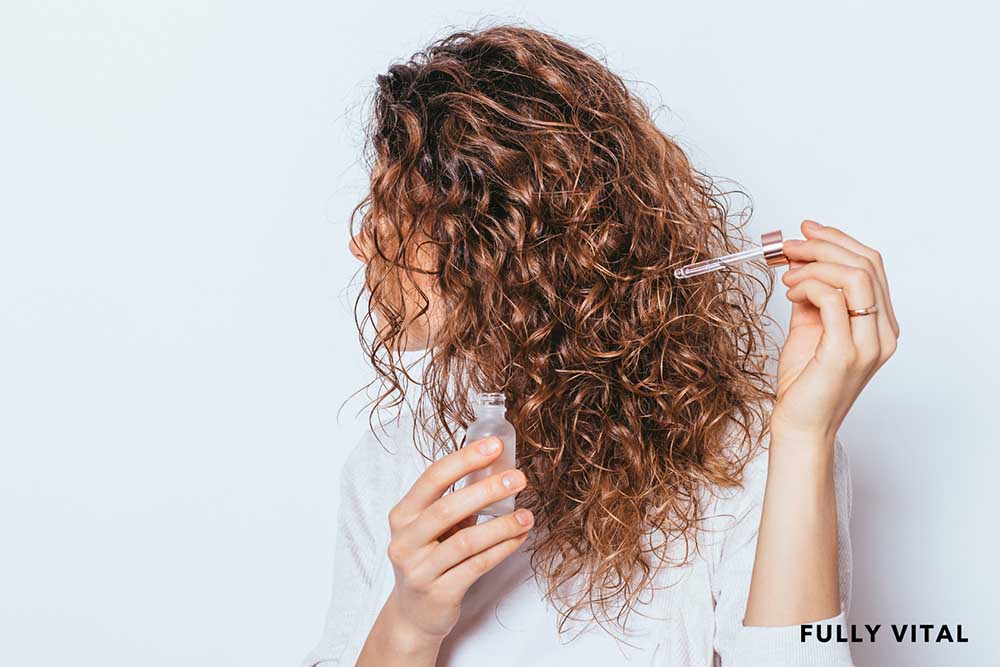
Caprylhydroxamic Acid: The Key to Combatting Hair Loss & Grey Hair
Welcome to our comprehensive guide on caprylhydroxamic acid (CHA) and its remarkable benefits when struggling with hair growth or combating grey hair.
If you're a woman experiencing hair loss or graying hair, you've come to the right place. Our Vegan Hair Growth System is specifically designed to address these concerns and help you regain luscious, healthy locks.

I LOVE MY HAIR NOW
FullyVital hair serum and hair vitamins made tremendous improvements in my hair. I truly love my hair now.
Dorit S.,
In this article, we'll delve into the world of caprylhydroxamic acid, exploring its significance, benefits, alternatives, historical usage, and much more.
What is Caprylhydroxamic Acid?
Caprylhydroxamic acid, commonly known as CHA, is a synthetic organic compound with potent antimicrobial properties.1
It belongs to the family of hydroxamic acids and is derived from coconut oil.
CHA has gained significant attention in the hair care industry due to its ability to inhibit the growth of harmful bacteria and fungi on the scalp, promoting a healthier environment for hair growth.

What Is The Significance of Caprylhydroxamic Acid?
Caprylhydroxamic acid plays a crucial role in combating grey hair and hair loss.
By maintaining a clean and balanced scalp, it helps prevent the buildup of harmful microorganisms that can lead to scalp conditions such as dandruff and fungal infections.
Moreover, CHA's antimicrobial properties contribute to a healthier hair follicle environment, supporting optimal hair growth and minimizing hair loss.
What Does Science Say About Caprylhydroxamic Acid?
Research studies have investigated the effectiveness of caprylhydroxamic acid (CHA) in promoting hair regrowth.
These studies have demonstrated that CHA, with its antimicrobial properties, helps create a healthy scalp environment by inhibiting the growth of harmful microorganisms.2
This clean scalp environment is conducive to optimal hair growth. Additionally, the molecular properties of CHA have shown potential in enhancing hair follicle health and vitality, leading to improved hair thickness and reduced hair loss.
While more research is needed to fully understand the extent of its benefits, the current scientific evidence suggests that CHA can play a valuable role in supporting hair regrowth.
What are the Benefits of Caprylhydroxamic Acid?
Antimicrobial Activity
CHA effectively inhibits the growth of bacteria and fungi, reducing the risk of scalp infections and associated hair loss.
Scalp Health
By creating an unfavorable environment for harmful microorganisms, CHA helps maintain a clean and balanced scalp, promoting healthier hair growth.
Hair Loss Prevention
The antimicrobial properties of caprylhydroxamic acid help prevent hair loss caused by scalp infections, contributing to thicker, fuller hair.
Anti-Gray Hair Effects
While CHA primarily focuses on scalp health, it indirectly aids in preventing premature graying by maintaining an optimal environment for hair follicles.
What Are the Different Forms of Caprylhydroxamic Acid?
Caprylhydroxamic acid (CHA) is primarily available in cosmetic formulations, including shampoos, conditioners, serums, and leave-in treatments.
These products incorporate CHA as an active ingredient to deliver its beneficial properties to the scalp and hair.
CHA is often used in combination with other ingredients to enhance its efficacy and provide a well-rounded hair care solution.
When seeking products containing CHA, carefully review the product labels or consult with a hair care professional to identify the specific form and concentration of CHA used in the formulation.
How Can I Incorporate Caprylhydroxamic Acid into My Hair Care Routine?
To incorporate caprylhydroxamic acid (CHA) into your hair care routine, look for hair care products that contain CHA as an active ingredient.
These products can include shampoos, conditioners, serums, or leave-in treatments. When using CHA-containing products, follow the instructions provided by the manufacturer.
Typically, this involves applying the product to wet hair, massaging it into the scalp, and allowing it to sit for a few minutes before rinsing.
It's important to be consistent with your usage to reap the benefits of CHA.
Additionally, consider complementing your CHA-based products with a well-rounded hair care routine that includes gentle cleansing, proper conditioning, and a balanced diet to further support healthy hair growth.
Why Should I Choose Professional Haircare Products with Caprylhydroxamic Acid?
Opting for professional hair care products that contain caprylhydroxamic acid (CHA) offers several advantages.
Professional-grade products are often formulated with higher concentrations of active ingredients, including CHA, ensuring that you're receiving the full benefits of this compound.
These products undergo extensive research and testing to deliver effective results. Additionally, professional hair care brands prioritize the use of high-quality ingredients and advanced formulations that are designed to nourish and rejuvenate the hair and scalp.3
By choosing professional hair care products with CHA, you can have confidence in the quality and efficacy of the product, ultimately supporting your journey towards healthier, more resilient hair.
How Often Should I Use Caprylhydroxamic Acid?
The frequency of caprylhydroxamic acid (CHA) usage will depend on the specific product you are using and the instructions provided by the manufacturer.
In most cases, it is recommended to use CHA-containing products two to three times per week. This allows for consistent application without overwhelming the scalp or hair follicles.
However, it's important to follow the guidelines provided with the specific product you are using. Overuse of CHA or any hair care product can potentially disrupt the scalp's natural balance.
If you have any concerns or specific hair care needs, consulting with a dermatologist or hair care professional can provide personalized guidance on the optimal frequency of CHA usage for your hair type and condition.
How Should I Store Caprylhydroxamic Acid?
To maintain the integrity and effectiveness of caprylhydroxamic acid (CHA)-containing products, it's important to store them properly.
Generally, CHA products should be stored in a cool, dry place away from direct sunlight. Follow the storage instructions provided by the manufacturer, as they may vary depending on the specific formulation.
Additionally, ensure that the product is securely closed after each use to prevent contamination or exposure to air. By storing CHA products correctly, you can maximize their shelf life and ensure that they remain effective for an extended period.
How Long Does It Take for Caprylhydroxamic Acid to Work?
The timeframe for visible results with caprylhydroxamic acid (CHA) can vary from person to person.
Consistency is key when using CHA-containing products. It is recommended to use the products as directed for a sustained period to allow sufficient time for the
CHA to have an impact on the scalp environment and hair follicles. In general, noticeable improvements may be observed after several weeks or months of regular use.
However, it's important to keep in mind that hair growth is a gradual process and results can be influenced by individual factors such as hair growth cycle and overall scalp health.
Patience and persistence are essential when incorporating CHA into your hair care routine.
What Role Does Diet and Nutrition Play in Enhancing Hair Growth with Caprylhydroxamic Acid?
Diet and nutrition play a vital role in enhancing hair growth, and when combined with caprylhydroxamic acid (CHA), they can amplify the results.
A well-balanced diet rich in essential nutrients such as vitamins (especially vitamins D, E, and biotin), minerals (such as iron and zinc), and proteins provides the building blocks necessary for healthy hair growth.
These nutrients support the overall health of the hair follicles, helping them produce stronger and more resilient hair strands.
Additionally, staying hydrated and consuming antioxidant-rich foods can help combat oxidative stress and promote scalp health.
When CHA is used in conjunction with a nutritious diet, it can further optimize the scalp environment for hair growth, resulting in healthier and more vibrant locks.
Are you ready to regain thicker, healthier hair? Discover the power of Fully Vital's Powerful Vegan Hair Regrowth System for Women.Our innovative formula stimulates hair follicles in four effective ways, revitalizing your hair from within. With just two minutes a day, you can enjoy the benefits of this easy-to-use system. Experience the transformation and boost your confidence with our Powerful Vegan Hair Regrowth System. We believe in the effectiveness of our product so strongly that we offer a 120-day money-back guarantee. Take the first step towards beautiful, voluminous hair by ordering now. Don't let thinning hair hold you back any longer. Join the countless women who have already embraced Fully Vital and unlocked their hair's true potential. Invest in yourself and your hair's future today. Order our Powerful Vegan Hair Regrowth System risk-free and start your journey towards radiant, healthy hair. |
What Are The Alternatives to Caprylhydroxamic Acid?
While caprylhydroxamic acid offers excellent benefits, it's important to explore alternative options that may suit your preferences or specific needs. Some alternatives to consider include:
Tea Tree Oil
Tea tree oil is renowned for its antimicrobial properties, making it an effective alternative to caprylhydroxamic acid. It helps combat scalp infections, such as dandruff and fungal conditions, which can contribute to hair loss.
Tea tree oil also soothes itchiness and inflammation, promoting a healthier scalp environment for hair growth.
Additionally, its refreshing scent can provide a pleasant aromatherapy experience during your hair care routine.
Rosemary Essential Oil
Rosemary oil stimulates blood circulation, nourishing hair follicles and promoting hair growth.
Aloe Vera
Aloe vera is a versatile plant known for its soothing and healing properties. When applied to the scalp, aloe vera gel calms inflammation and irritation, making it suitable for sensitive scalps.
It helps moisturize the scalp and hair, reducing dryness and flakiness. Aloe vera also contains enzymes that promote healthy hair growth by removing dead skin cells from the scalp and unclogging hair follicles.
Furthermore, it has a cooling sensation that can provide relief from scalp discomfort.
Probiotics
Probiotics are beneficial bacteria that can be taken orally or applied topically to support a healthy scalp environment.
These live microorganisms help restore the natural balance of the scalp's microbiome, which can be disrupted by factors like stress, environmental pollutants, or harsh hair products.
By enhancing the scalp's beneficial bacteria, probiotics help prevent the overgrowth of harmful microbes and create an optimal environment for hair growth.
Probiotics can be found in certain hair care products or obtained through dietary supplements.
Coconut Oil
Coconut oil, from which caprylhydroxamic acid is derived, has long been used in traditional hair care practices.
It is a natural emollient that deeply moisturizes the hair and scalp, preventing dryness and promoting overall hair health.
Coconut oil also possesses antimicrobial properties that help combat scalp infections.
It strengthens the hair shaft, reducing breakage and damage. Additionally, coconut oil adds shine and smoothness to the hair, enhancing its appearance.
Final Thoughts
Caprylhydroxamic acid (CHA) has emerged as a promising ingredient in the realm of hair regrowth and combating grey hair.
Its unique properties, derived from coconut oil, make it a valuable addition to hair care formulations aimed at promoting a healthy scalp environment and stimulating hair growth.
Throughout this article, we have explored the various aspects of caprylhydroxamic acid, including its definition, importance, benefits, alternatives, historical usage, and more.
We have addressed common questions and provided comprehensive information to empower women experiencing hair loss or greying hair.
At Fully Vital, we understand the challenges and concerns associated with hair regrowth, and that's why we have developed our Powerful Vegan Hair Regrowth System for Women.
Our system utilizes the power of caprylhydroxamic acid along with other key ingredients to stimulate hair follicles in four different ways, promoting natural and healthy hair growth.
With just two minutes of daily usage, our product offers a convenient and effective solution for your hair regrowth journey.
We are so confident in the efficacy of our product that we back it up with a 120-day money-back guarantee.
We believe in the transformative potential of our Powerful Vegan Hair Regrowth System, and we are committed to helping you regain confidence and achieve the luscious hair you desire.
Take the first step towards healthier and fuller hair today by trying our Powerful Vegan Hair Regrowth System. Embrace the power of caprylhydroxamic acid and experience the difference for yourself.
Your hair deserves the best, and Fully Vital is here to support you on your hair regrowth journey.
Frequently Asked Questions About Caprylhydroxamic Acid (FAQ)
Can caprylhydroxamic acid reverse grey hair?
Caprylhydroxamic acid primarily focuses on maintaining a healthy scalp environment, indirectly aiding in preventing premature graying. However, it is not specifically formulated to reverse existing grey hair.
Can caprylhydroxamic acid be used on color-treated hair?
Caprylhydroxamic acid is generally safe for use on color-treated hair. However, it's recommended to check the specific instructions of the product you're using or consult a professional hair stylist for personalized advice.
Is caprylhydroxamic acid vegan-friendly?
Caprylhydroxamic acid is vegan-friendly. It is derived from coconut oil and does not involve the use of animal-derived ingredients.
Is caprylhydroxamic acid suitable for all hair types?
Caprylhydroxamic acid is generally suitable for all hair types. It is designed to promote a healthy scalp environment and support hair growth, regardless of hair texture or type. Whether you have straight, wavy, curly, or coily hair, products containing CHA can be incorporated into your hair care routine to provide the desired benefits.
Can caprylhydroxamic acid be used with other hair care products or treatments?
Caprylhydroxamic acid can generally be used in conjunction with other hair care products or treatments. It is often found as an ingredient in various hair care formulations, including shampoos, conditioners, and serums.
However, if you are using specialized treatments or undergoing specific hair care procedures, it's advisable to consult with a hair care professional to ensure compatibility and the best course of action.
Can caprylhydroxamic acid be used by men experiencing hair loss or grey hair?
Caprylhydroxamic acid can be used by men experiencing hair loss or grey hair. While the target audience for CHA-containing products is often women, the benefits of CHA can be equally applicable to men.
The compound's properties support a healthy scalp environment and hair growth, making it suitable for individuals of all genders.
Are there any age restrictions for using caprylhydroxamic acid?
Caprylhydroxamic acid is generally safe for individuals of various age groups.
However, for specific concerns related to children or older adults, it's advisable to consult with a healthcare professional or pediatrician to ensure suitability and optimal usage.
Sources:
- Bergfeld, W., Donald, F., Belsito, V., Klaassen, C., Liebler, D., Marks, J., Peterson, L., Shank, R., Slaga, T., Snyder, P., & Fiume, M. (2019). Safety Assessment of Caprylhydroxamic Acid as Used in Cosmetics. https://www.cir-safety.org/sites/default/files/Caprylhydroxamic%20Acid_0.pdf
- Bergfeld, W., Donald, F., Belsito, V., Klaassen, C., Liebler, D., Marks, J., Peterson, L., Shank, R., Slaga, T., & Snyder, P. (n.d.). Safety Assessment of Caprylhydroxamic Acid as Used in Cosmetics. Retrieved June 9, 2023, from https://www.cir-safety.org/sites/default/files/Caprylhydroxamic%20Acid_3.pdf
- What is Caprylhydroxamic Acid? | Honest. (n.d.). Www.honest.com. Retrieved June 9, 2023, from https://www.honest.com/blog/wellness/ingredients/what-is-caprylhydroxamic-acid/13775.html







